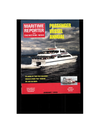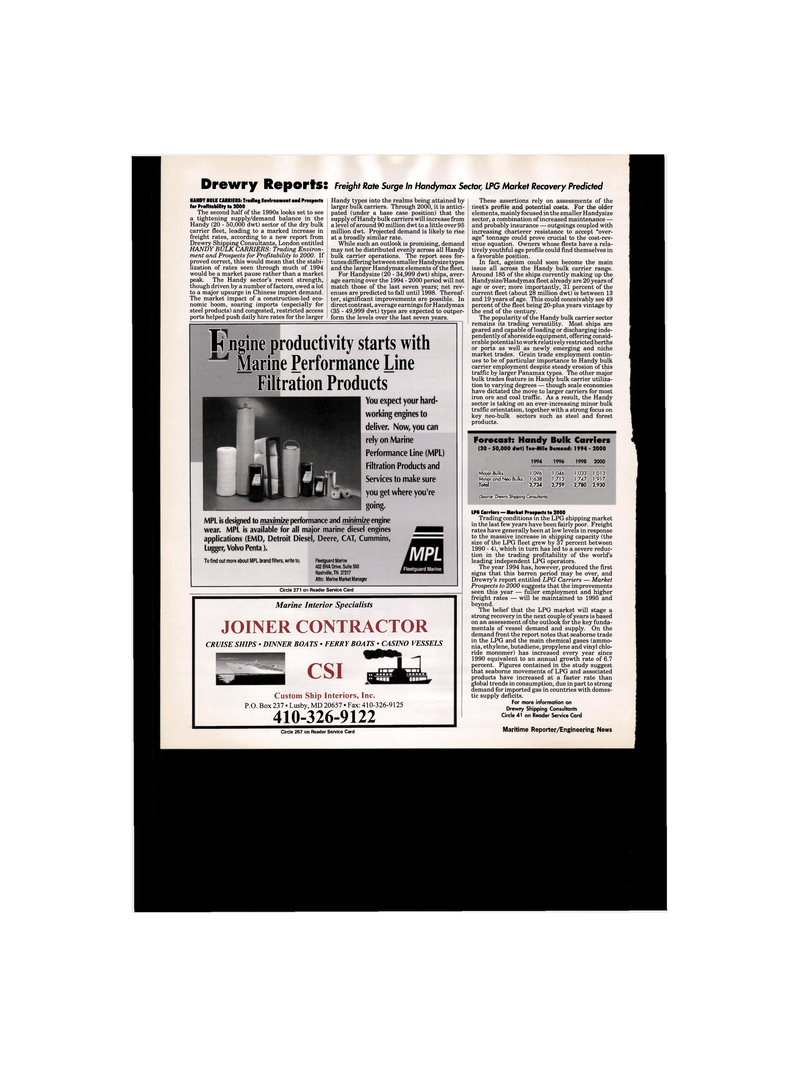
Page 58: of Maritime Reporter Magazine (January 1995)
Read this page in Pdf, Flash or Html5 edition of January 1995 Maritime Reporter Magazine
Drewry Reports: Freight Rate Surge In Handymax Sector, LPG Market Recovery Predicted
HANDY BULK CARRIERS: Trading Environment and Prospects for Profitability to 2000
The second half of the 1990s looks set to see a tightening supply/demand balance in the
Handy (20 - 50,000 dwt) sector of the dry bulk carrier fleet, leading to a marked increase in freight rates, according to a new report from
Drewry Shipping Consultants, London entitled
HANDY BULK CARRIERS: Trading Environ- ment and Prospects for Profitability to 2000. If proved correct, this would mean that the stabi- lization of rates seen through much of 1994 would be a market pause rather than a market peak. The Handy sector's recent strength, though driven by a number of factors, owed a lot to a major upsurge in Chinese import demand.
The market impact of a construction-led eco- nomic boom, soaring imports (especially for steel products) and congested, restricted access ports helped push daily hire rates for the larger
Handy types into the realms being attained by larger bulk carriers. Through 2000, it is antici- pated (under a base case position) that the supply of Handy bulk carriers will increase from a level of around 90 million dwt to a little over 95 million dwt. Projected demand is likely to rise at a broadly similar rate.
While such an outlook is promising, demand may not be distributed evenly across all Handy bulk carrier operations. The report sees for- tunes differing between smaller Handysize types and the larger Handymax elements of the fleet.
For Handysize (20 - 34,999 dwt) ships, aver- age earning over the 1994 - 2000 period will not match those of the last seven years; net rev- enues are predicted to fall until 1998. Thereaf- ter, significant improvements are possible. In direct contrast, average earnings for Handymax (35 - 49,999 dwt) types are expected to outper- form the levels over the last seven years.
These assertions rely on assessments of the _ i _ J j J • _ 1 j_ T71 _ . Jl _ 11
Forecast: Handy Bulk Carriers (20 - 50,000 dwt) Ton-Mile Demand: 1994 - 2000 1994 1996 1998 2000
Major Bulks 1,096 1,046 1,033 1,013
Minor and Neo Bulks 1,638 1,713 1,747 1,917
Total 2,734 2,759 2,780 2,930
ISource: Drewry Shipping Consultants)
IPG Carrier* — Market Prospects to 2000
Trading conditions in the LPG shipping market in the last few years have been fairly poor. Freight rates have generally been at low levels in response to the massive increase in shipping capacity (the size of the LPG fleet grew by 37 percent between 1990 - 4), which in turn has led to a severe reduc- tion in the trading profitability of the world's leading independent LPG operators.
The year 1994 has, however, produced the first signs that this barren period may be over, and
Drewry's report entitled LPG Carriers — Market
Prospects to 2000 suggests that the improvements seen this year — fuller employment and higher freight rates — will be maintained to 1995 and beyond.
The belief that the LPG market will stage a strong recovery in the next couple of years is based on an assessment of the outlook for the key funda- mentals of vessel demand and supply. On the demand front the report notes that seaborne trade in the LPG and the main chemical gases (ammo- nia, ethylene, butadiene, propylene and vinyl chlo- ride monomer) has increased every year since 1990 equivalent to an annual growth rate of 6.7 percent. Figures contained in the study suggest that seaborne movements of LPG and associated products have increased at a faster rate than global trends in consumption, due in part to strong demand for imported gas in countries with domes- tic supply deficits.
For more information on
Drewry Shipping Consultants
Circle 41 on Reader Service Card
Tuigine productivity starts with Marine Performance Line
Filtration Products
You expect your hard- working engines to deliver. Now, you can rely on Marine
Performance Line (MPL)
Filtration Products and
Services to make sure you get where you're going.
MPL is designed to maximize performance and minimize engine wear. MPL is available for all major marine diesel engines applications (EMD, Detroit Diesel, Deere, CAT, Cummins,
Lugger, Volvo Penta).
To find out more about MPL brand filters, write to: Fleetguard Marine 402 BNA Drive. Suite 500
Nashville, TN 37217
Attn: Marine Market Manager
Circle 271 on Reader Service Card
Marine Interior Specialists
JOINER CONTRACTOR
CRUISE SHIPS • DINNER BOATS • FERRYBOATS • CASINO VESSELS
CSI
Custom Ship Interiors, Inc.
P.O. Box 237 • Lusby, MD 20657 • Fax: 410-326-9125 410-326-9122 iieets pronle and potential costs, r or tne older elements, mainly focused in the smaller Handysize sector, a combination of increased maintenance — and probably insurance — outgoings coupled with increasing charterer resistance to accept "over- age" tonnage could prove crucial to the cost-rev- enue equation. Owners whose fleets have a rela- tively youthful age profile could find themselves in a favorable position.
In fact, ageism could soon become the main issue all across the Handy bulk carrier range.
Around 185 of the ships currently making up the
Handysize/Handymax fleet already are 20 years of age or over; more importantly, 31 percent of the current fleet (about 28 million dwt) is between 13 and 19 years of age. This could conceivably see 49 percent of the fleet being 20-plus years vintage by the end of the century.
The popularity of the Handy bulk carrier sector remains its trading versatility. Most ships are geared and capable of loading or discharging inde- pendently of shoreside equipment, offering consid- erable potential to work relatively restricted berths or ports as well as newly emerging and niche market trades. Grain trade employment contin- ues to be of particular importance to Handy bulk carrier employment despite steady erosion of this traffic by larger Panamax types. The other major bulk trades feature in Handy bulk carrier utiliza- tion to varying degrees — though scale economies have dictated the move to larger carriers for most iron ore and coal traffic. As a result, the Handy sector is taking on an ever-increasing minor bulk traffic orientation, together with a strong focus on key neo-bulk sectors such as steel and forest products.
Circle 267 on Reader Service Card Maritime Reporter/Engineering News

 57
57

 59
59
